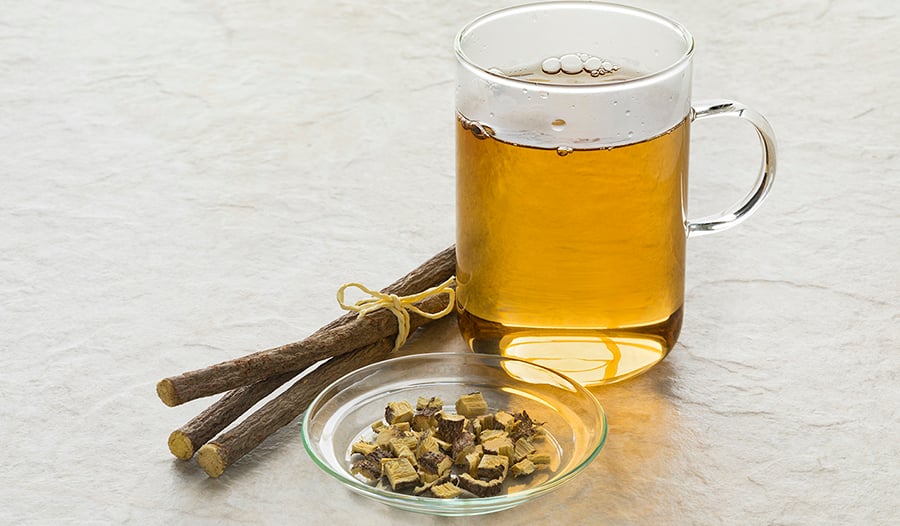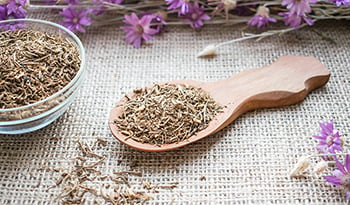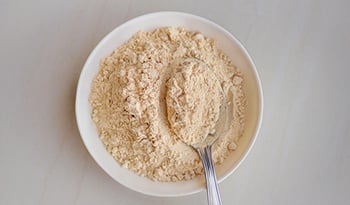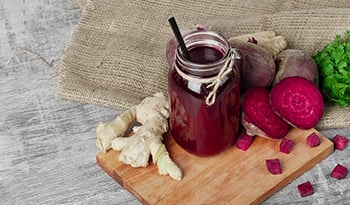Licorice Root’s Health Benefits—From Brighter Skin to Better Digestion
DISCLAIMER:This blog does not intend to provide diagnosis...
- In this article:
- Benefits Studied in Traditional Chinese Medicine
- Benefits Studied in Western Medicine
- Brighter, Healthier Skin
- Additional Health Benefits of Licorice Root
- Toxicity
- Drug Interactions
- Caution
- Summary

Licorice Root, known as Gan Cao or Radix Glycyrrhizae, comes from the Chinese licorice plant Glycyrrhiza uralensis. It is one of the most commonly used herbs in Traditional Chinese Medicine (TCM). Traditionally used in cooking to aid digestion, licorice root offers an array of health benefits. In TCM, licorice root boosts Spleen functions and cools the body.
Gan Cao is available as a dried root, peeled or unpeeled, mostly in raw or powdered form. Unlike most herbs, licorice root’s therapeutic effects differ depending on how it is prepared.
The two most popular preparation methods include dry-frying sliced licorice with bran until it turns dark and steeping licorice root in boiled water and honey to make a tea. The steeping preparation method increases licorice’s ability to strengthen the digestive system, boost Qi in the body, and harmonize with other herbs.
You have probably also seen licorice available as a confectionary candy. However, the candy doesn’t offer any therapeutic effect. It doesn’t even contain licorice—it gets its flavor from anise oil!
Benefits Studied in Traditional Chinese Medicine
In TCM, licorice root has a moderating and harmonizing nature. It is known as a “guiding herb” because when combined with other herbs, it helps mitigate their harsh actions, allowing the body to absorb, process, and use them more effectively. Because of this, it is regarded as a “wise elder statesman” or Guo Lao.
Licorice root has a characteristic sweet flavor. Its name, Gan Cao, translates to “sweet herb.” This sweet flavor is regarded as strengthening, harmonizing, and moistening and helps guide Qi to the Spleen. Because of its sweet nature, licorice is considered nourishing, gentle, and safe for almost everyone.
In TCM, the Spleen represents the organ that digests food and life events. It is an Earth element, grounded in nature, and helps aid digestion, nourishment, and distribution of nutrients throughout the body.
Therapeutic Actions: Tonifying the Spleen, Alleviating Coughs, Moistening the Lungs
Gan Cao’s main actions are augmenting Qi and tonifying the Spleen. It can help alleviate both productive and dry coughs and moisten the lungs.
According to a 2013 Tianjin University of TCM study, licorice root is the most commonly used herb. It is an ambassador to most herbs and is considered the equalizer in harmonizing them in TCM herbal formulas.
How licorice root is prepared determines its therapeutic actions on the body:
- When prepared raw, licorice root helps strengthen the Spleen, drains fire, and resolves toxicity. The tips of the root can help ease urethral pain and urinary tract infections.
- When licorice root is cooked, it helps tonify the Spleen, Stomach, and digestive system by lifting the Qi. It can help alleviate diarrhea, cough, shortness of breath, and lack of energy while reinforcing the Spleen.
Licorice root can also moderate abdominal and leg muscle spasms and alleviate pain when combined with the herb Paeoniae Radix Alba (Bai Shao).
Benefits Studied in Western Medicine
Licorice root contains over 170 different chemical compounds. The compounds that contribute to licorice root’s medicinal effects fall into four categories:
- Coumarins: pharmacological agents with a wide range of physiological effects on the body, including antioxidant, anti-inflammatory, antibacterial, anticoagulant, chemopreventive, and antibacterial
- Triterpenoids: compounds with antidiabetic properties that may help prevent development of insulin resistance
- Flavonoids: powerful antioxidants that help protect your cells from oxidative damage
- Stilbenoids: compounds that may have anti-inflammatory, neuroprotective, chemopreventive, and cardioprotective properties
Researchers have identified the antioxidant glycyrrhizin as the primary active ingredient in licorice root. Studies suggest glycyrrhizin may help protect against severe acute respiratory syndrome.
A small 2003 study looked at the effect of glycyrrhizin on 37 people diagnosed with acute respiratory syndrome. Those who took glycyrrhizin experienced an improvement in symptoms like dry cough, chest discomfort, and dyspnea. Their levels of aminotransferases also declined, and their hospital stays were shorter.
The study authors suggest glycyrrhizin may also help treat acute respiratory syndrome since these viruses have several important similarities.
However, this was a small observational study. More well-designed studies need to be conducted to know if glycyrrhizin or licorice root could help recover faster from acute respiratory syndrome.
Animal studies suggest licorice root may act as an antiviral agent again hepatitis C. In one study, mice fed licorice root experienced a 50% rate reduction of the hepatitis C virus.
Brighter, Healthier Skin
Licorice root may offer skin benefits as well. It contains the isoflavone glabridin, an anti-inflammatory and skin-brightening ingredient, which may help reverse free radical damage caused by UV rays. When used topically, gladbridin can help diminish dark spots and hyperpigmentation. Some consider it a pregnancy-safe alternative to retinol.
Glycyrrhizin, the active ingredient in licorice root, may also help treat skin issues like psoriasis, rosacea, and atopic dermatitis.
Additional Health Benefits of Licorice Root
Preliminary studies suggest licorice root may also offer the following health benefits:
- Menopausal Symptoms Reduction: Licorice root contains phytoestrogen, which may help relieve symptoms of menopause. In a 2012 study, 90 women with hot flashes took 330mg of licorice root or a placebo for eight weeks. Those who took the licorice root experienced significantly fewer and less severe hot flashes compared to those who took the placebo. Two weeks after treatment with licorice root stopped, symptoms returned.
- Relief From Peptic Ulcers: In one study, taking licorice root along with standard treatment eliminated H. Pylori—the bacteria responsible for ulcers—by over 20% more than standard treatment alone.
Toxicity
Licorice Root is generally considered safe when used under the supervision of a doctor. Those ingesting licorice root long-term may experience severe symptoms such as salt retention, high blood pressure, spasms, numbness, dizziness, and headache.
People with edema, congestive heart failure, high blood pressure, low potassium, or a licorice allergy should avoid taking licorice root. Pregnant women should only take it under the supervision of a doctor.
As with all supplements and herbs, it’s best to consult your doctor before taking licorice root to ensure you’re taking the correct dose and that it won’t interact with any medications you are taking.
Drug Interactions
Licorice root can interact with several medications by lowering the effectiveness of the medication or making side effects worse. These medications include:
- Heart arrhythmia drugs like Lanoxin (digoxin)
- High blood pressure drugs like Cozaar (losartan)
- Blood thinners like Coumadin (warfarin)
- Estrogen-based contraceptives
- Celebrex (celecoxib) and Voltaren (diclofenac)
- Cholesterol drugs like Lescol (fluvastatin)
- Nonsteroidal anti-inflammatory drugs (NSAIDs) like Advil (ibuprofen)
- Diuretics like Lasix (furosemide)
As with all supplements and herbs, it’s best to consult your doctor before taking licorice root to ensure you’re taking the correct dose and that it won’t interact with any medications you are taking.
Caution
In 2017, the FDA issued a warning that adults who consume more than 2 ounces of natural black licorice daily for over weeks are at risk for cardiac arrhythmia and other serious side effects. Always use licorice root under the care of a physician to be sure you are taking the correct dose for you.
Summary
Licorice Root has been the most commonly used medicinal herb in Traditional Chinese Medicine for thousands of years. Its potential health benefits include supporting recovery from respiratory infection, protection from peptic ulcers, and brighter, healthier skin.
Since licorice root can interact with certain medications and lead to serious health issues if taken in high doses, it should always be used under the care of a physician.
References:
- Akinwumi BC, Bordun KM, Anderson HD. Biological Activities of Stilbenoids. Int J Mol Sci. 2018;19(3):792. Published 2018 Mar 9. doi:10.3390/ijms19030792
- Chrzanowski, J, Chrzanowska, A, Graboń, W. Glycyrrhizin: An old weapon against a novel coronavirus. Phytotherapy Research. 2021; 35: 629– 636. https://doi.org/10.1002/ptr.6852
- Jafari Z, Emtiazy M, Sohrabvand F, Talei D, Oveidzadeh L, et al. The effect of Glycyrrhiza glabra L. on Primary Dysmenorrhea compared with Ibuprofen: A Randomized, Triple-Blind Controlled Trial. Iran J Pharm Res. 2019;18(Suppl1):e124461. doi: 10.22037/ijpr.2020.1100961.
- Hajiaghamohammadi AA, Zargar A, Oveisi S, Samimi R, Reisian S. To evaluate of the effect of adding licorice to the standard treatment regimen of helicobacter pylori. The Brazilian Journal of Infectious Diseases. 2016;20(6):534-538. doi: 10.1016/j.bjid.2016.07.015
- Nahidi F, Zare E, Mojab F, Alavi-Majd H. Effects of licorice on relief and recurrence of menopausal hot flashes. Iranian Journal of Pharmaceutical Research: IJPR. 2012;11(2):541-8.
- NIH National Center for Complementary and Integrative Health. Licorice root. Accessed September 23, 2022
- Wu L, Wang X, Xu W, Farzaneh F, Xu R. The structure and pharmacological functions of coumarins and their derivatives. Curr Med Chem. 2009;16(32):4236-4260. doi:10.2174/092986709789578187
- Zhao H, Zhang X, Chen X, et al. Isoliquiritigenin, a flavonoid from licorice, blocks M2 macrophage polarization in colitis-associated tumorigenesis through downregulating PGE2 and IL-6. Toxicology and Applied Pharmacology. 2014;279(3):311-321. doi:10.1016/j.taap.2014.07.001

 By Dr. Debbie Kung, DAOM, LAc.
By Dr. Debbie Kung, DAOM, LAc.


